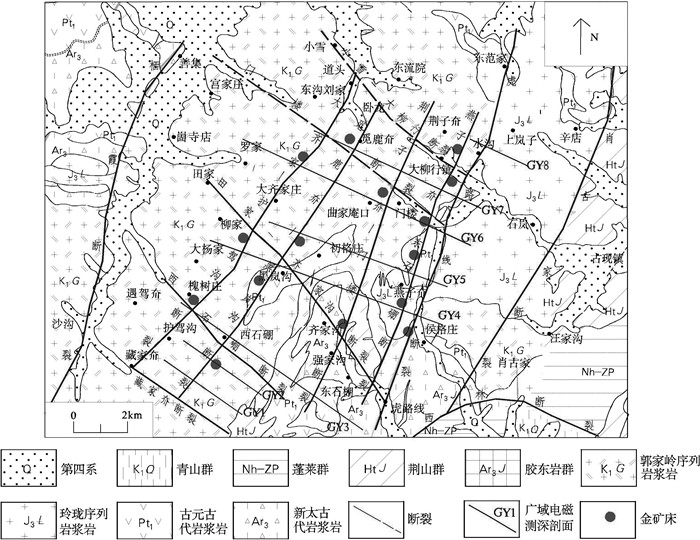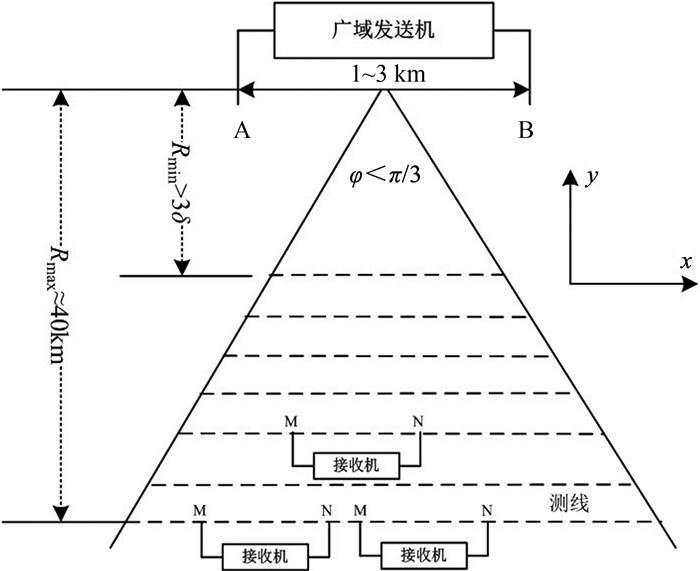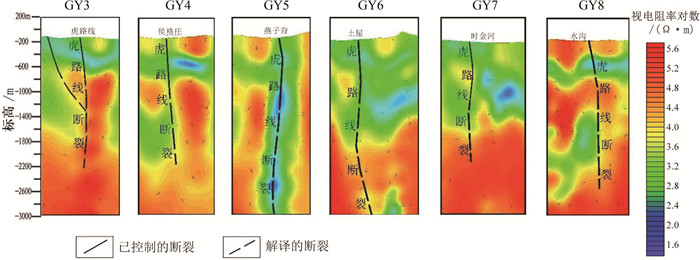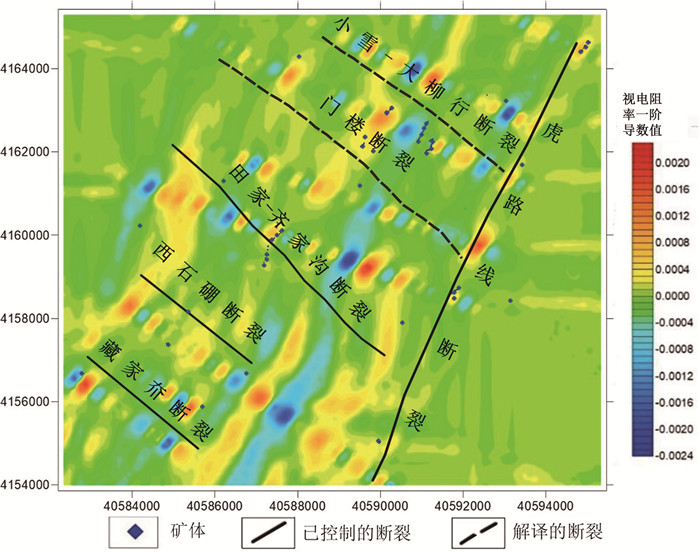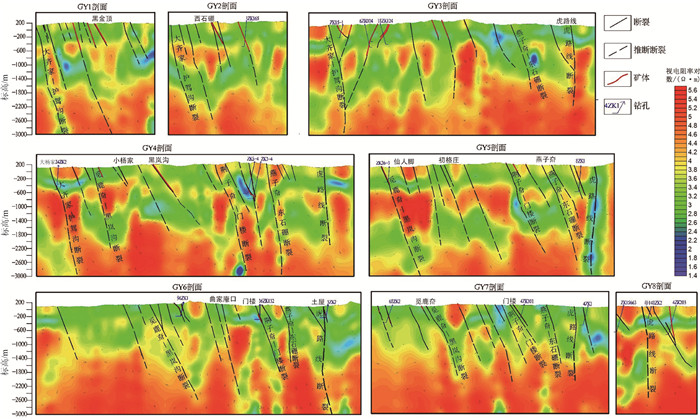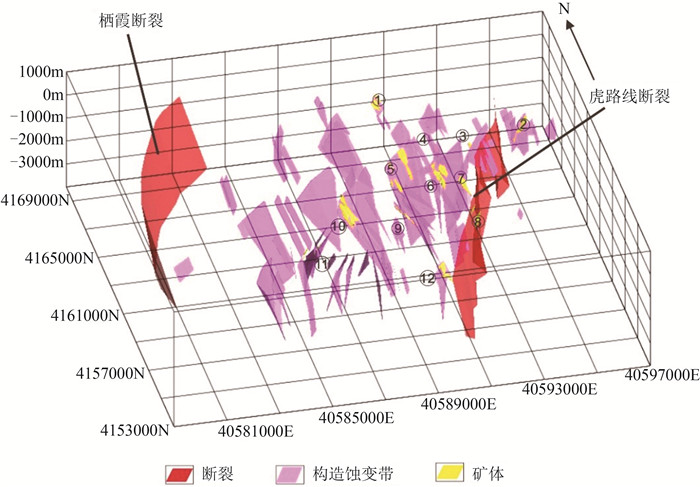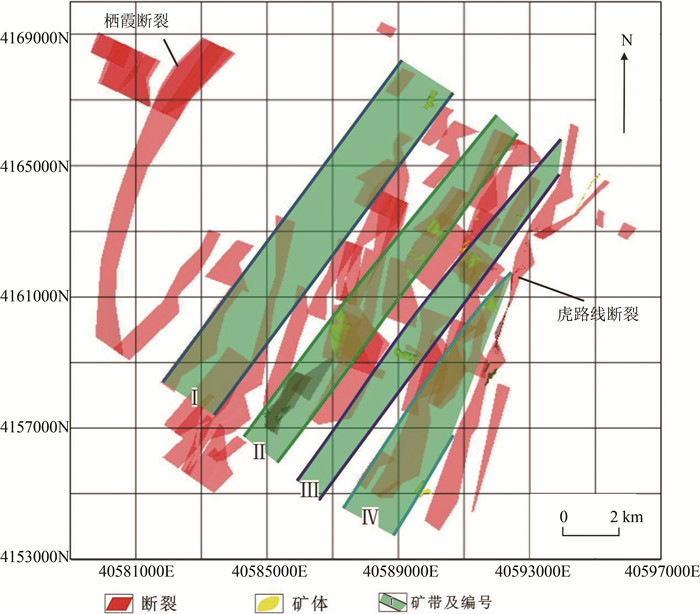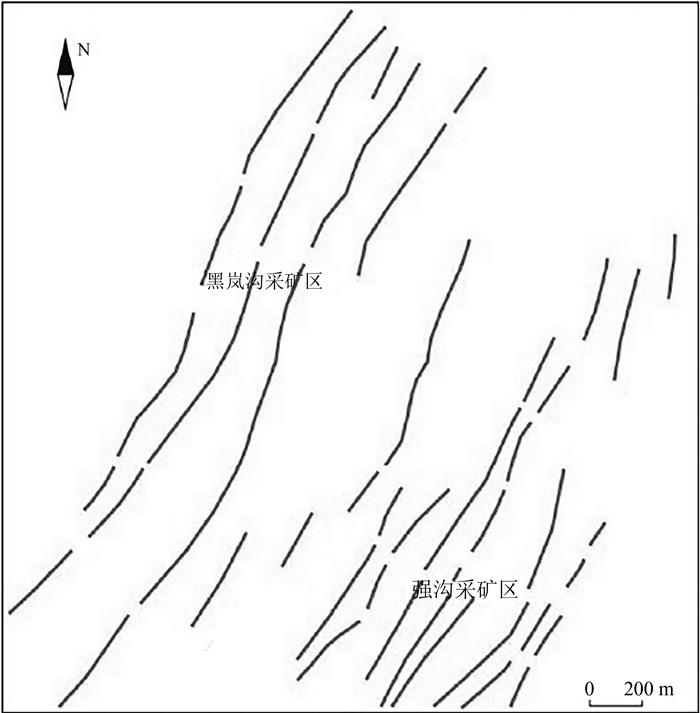Wide field electromagnetic exploration and prospecting of metallogenic structures in Daliuhang gold field, the north of Jiaodong
-
摘要:
大柳行金矿田位于胶东金矿集区三大成矿带之一的栖霞-蓬莱金矿带内,成矿构造研究一直是找矿工作的基础和前提。通过实施8条广域电磁测深剖面,进行一维反演和水平方向导数的求取,推断解释了大柳行金矿田的深部地质结构和断裂空间分布,并以此为基础分析了断裂控矿规律和找矿方向。在视电阻率剖面上,浅部出现大面积的低阻异常区,深部高阻异常较明显,水平方向一阶导数图显示NE—NNE向的带状视电阻率异常出现错断或扭折现象。推断解译表明,研究区浅表部主要为晚白垩世花岗岩,深部主要为早前寒武纪变质基底岩系,区内断裂构造非常发育。推断解译的虎路线断裂倾角较陡,断裂南段和北段延深约在-2000 m标高以上,中段延深至少可达-3000 m标高;NNE走向的4条主要控矿断裂倾角均较陡,并在标高-600 m左右和-1600 m左右均有明显变缓表现,断裂延深均超过-2000 m标高,最深处超过-3000 m;推断了5条NW向成矿后断裂,其中2条是新发现的断裂。综合分析认为,区内控矿断裂为虎路线断裂的次级断裂,而且前者可能是金成矿的导矿断裂;研究区南部4条主要控矿断裂2000~3000 m深度范围、虎路线断裂深部倾角波状变化部位和主要控矿断裂旁侧与其平行、等间距分布的小规模断裂、裂隙是今后找矿的重点方向。
Abstract:Daliuhang gold field is located in Qixia-Penglai gold belt, one of the three major metallogenic belts in Jiaodong gold concentration area.The study of metallogenic structure has always been the basis and premise of prospecting.Through the implementation of 8 wide area electromagnetic sounding profiles, one-dimensional inversion and horizontal derivative calculation, the deep geological structure and fault spatial distribution of Daliuhang gold field are inferred and explained, and the fault ore control law and prospecting direction are analyzed on this basis.On the apparent resistivity profile, there is a large area of low resistivity anomaly in the shallow, and the deep high resistivity anomaly is more obvious.The horizontal first-order derivative diagram shows that the NE-NNE zonal apparent resistivity anomaly is broken or twisted.The inferred interpretation shows that the shallow part of the study area is mainly Late Cretaceous granite, and the deep part is mainly Early Precambrian metamorphic basement rock series.The fault structures in the area are very developed.It is inferred that the slope angle of the tiger line fault interpreted is relatively steep, the extension depth of the South and North segments of the fault is about more than -2000 m, and the extension depth of the middle segment is at least -3000 m; The dip angles of the four main ore controlling faults in NNE trend are steep, and they are obviously slowed down at the elevation of about -600 m and -1600 m.the extension depth of the faults exceeds the elevation of -2000 m, and the deepest is more than -3000 m; Five NW trending post metallogenic faults are inferred, of which two are newly discovered faults.The comprehensive analysis shows that the ore controlling fault in the area is a secondary fault of the tiger line fault, and the former may be the ore guiding fault of gold mineralization; The depth range of 2000 ~ 3000 m of the four main ore controlling faults in the south of the study area, the deep dip wavy change position of the tiger line fault, and the small-scale faults and fissures parallel to and equidistant from the main ore controlling faults are the key directions for ore prospecting in the future.
-
胶东地区累计探明金资源储量超过5000 t,占全国的1/3左右,是中国最重要的黄金基地,也是全球第三大金成矿省[1-3]。胶东金矿成矿深度集中于4~10 km,总剥蚀量2.0~4.3 km,目前多数矿山开采深度小于1 km,说明胶东半岛深部找矿潜力巨大[4-7]。断裂构造是胶东金矿的关键控制因素[8-10],对其深入研究可以揭示矿床分布规律和成矿过程,对深部找矿具有重要意义。
大柳行金矿田是石英脉型金矿的重要产区,矿床均受断裂构造控制,以往对断裂空间分布及控矿规律进行了较多研究,但受勘查、开采深度和深部探测方法的限制,对断裂构造的深部特征尚缺乏直观的认识。广域电磁法具有探测深度大、精度高、对深部构造探测效果突出等特点[11-14],为深部地质结构和断裂构造研究提供了重要的技术手段。本文采用该方法结合详细的地质调查及矿区地质资料,揭示了大柳行金矿田-3000 m以浅断裂构造的深部形态和展布特征,探讨了断裂控矿规律,对该区深部找矿具有指导意义。
1. 区域和研究区地质概况
胶东地区位于华北克拉通东部,由苏鲁超高压变质带(威海隆起)、胶北隆起和胶莱盆地3个地质构造单元组成。区域断裂构造发育,以大致呈NE—NNE向展布(图 1)的断裂为主,包括三山岛断裂、焦家断裂、招平断裂、牟平-乳山断裂、五莲-青岛-烟台断裂等[15-16],这些断裂被认为是区域性郯城-庐江大断裂的次级断裂[17-19]。金矿床主要沿晚中生代花岗质侵入体内部及边缘的NE—NNE向断裂破碎带分布,NE向和NNE向断裂构造分别控制该区金矿带的展布和金矿床的产出位置[20-22]。按照金矿床的分布特点,将其划分为胶西北、栖蓬福和牟乳三大成矿带,进一步划分为多处金矿田,其中,栖蓬福成矿带包括大柳行金矿田和栖霞金矿田。
![]() 图 1 胶东半岛地质简图(据参考文献[1]修改)
图 1 胶东半岛地质简图(据参考文献[1]修改)
1—第四系;2—白垩系;3—古元古界和新元古界;4—含榴辉岩的新元古代花岗质片麻岩;5—太古宙花岗岩-绿岩带;6—白垩纪崂山型花岗岩;7—白垩纪伟德山型花岗岩;8—白垩纪郭家岭型花岗岩;9—侏罗纪花岗岩类;10—三叠纪花岗岩类;11—地质界限;12—断层;13—蚀变岩型和网脉型金矿,石英脉型和硫化物石英脉型金矿,以及蚀变角砾岩型、蚀变砾岩型和层间滑脱拆离带型金矿;F1—三山岛断裂;F2—焦家断裂;F3—招平断裂;F4—西林断裂;F5—金牛山断裂;ME1—胶西北成矿区;ME2—栖蓬福成矿区;ME3—牟乳成矿区Figure 1. Geological map of Jiaodong Peninsula大柳行金矿田位于胶东隆起北部[23]。研究区地层主要有新太古代胶东变质杂岩、新元古代荆山群、新元古代蓬莱群、白垩系青山群及新生界第四系(图 2)。岩浆岩主要发育新太古代、古元古代及中生代侵入岩,其中,新太古代、古元古代侵入岩分布于研究区东南侧及西北角,侏罗纪玲珑序列侵入岩主要分布于研究区东侧,早白垩世郭家岭序列侵入岩在中部大面积分布。燕山期脉岩遍布全区。
研究区经历了多期构造活动,发育了纵横交错的复杂构造网络。主要断裂构造产状可分为4组:NNE向、NE向、近EW向和NW向。栖霞断裂、虎路线断裂为矿区边界断裂,基本不含矿,其派生的大量NNE向次级断裂控制了研究区主要金矿床的产出;NE向断裂构造主要为西部邻近栖霞断裂的一组断裂构造;近EW向断裂以西林断裂为代表,位于研究区南部边界,其内发育西林金矿;NW向断裂较少,规模一般较小,前人已发现的NW向断裂主要为研究区西南部的臧家夼断裂、西石硼断裂、田家-齐家沟断裂,本次新发现2条隐伏断裂,分别为门楼断裂和小雪-大柳行断裂(图 2)。
大柳行金矿田已发现黑岚沟、门楼、庵口、齐家沟、强家沟等30多个金矿床,其中黑岚沟金矿床达大型规模,其余均为中小型矿床。矿床类型以石英脉型为主,少数为蚀变岩型,虽然矿床规模不大,但矿石品位较高,常可见明金。研究者普遍认为,其与胶西北成矿小区中的金矿床均为形成于白垩纪的热液脉型金矿[24-25]。
2. 研究方法
广域电磁法已经在胶东金矿深部探测中得到应用[26-27]。本次研究应用广域电磁法探测大柳行金矿田的深部结构和主要断裂构造的深部特征,发射机采用JSDY-180型号,广域电磁仪系统采集仪器为JSGY-2型号,采用三相交流发电机,最高功率达200 kW。场源电极(A、B)根据实际地形、地物情况,远离人员聚集地区部署,平行于测线方向布设,方位误差小于1°,场源AB长度为1 km左右。测线两端与垂直场源中心点垂线夹角均小于30°,如图 3所示。
野外工作选定的收发距为15.03~18.2 km。每次采集之前均进行了接地电阻测量,不大于5 kΩ。测点观测全部在场源AB垂直平分线两侧30°角扇形范围内进行,AB场源的接地电阻均不大于30 Ω。有些情况下,电极坑本身土质不好,则从其他地方取土填埋,以确保获得较小的接地电阻。发射机最高供电电压和电流一般为额定值的70%,系统稳定安全,有效电流值一般控制在100 A左右。
共完成50 km/8条剖面采集(图 2),测点604个,基本点距100 m,局部加密至50 m。自南向北,剖面依次编号为GY1~GY8,剖面方向为NWW—SEE向,与研究区主干构造线基本垂直,剖面间距为1~2 km,各剖面穿越了研究区已知的主要矿带,如GY1、GY2剖面横穿了黑金顶矿区,GY3剖面穿越了强家沟、虎路线金矿区,GY4剖面穿越了黑岚沟、齐沟一分矿金矿区等,各剖面在空间上略呈等距性,基本覆盖研究区。
广域电磁法勘探属于体积勘探范畴,电阻率异常反映了地下介质的电阻率分布,各种处理方法所得的资料均能从不同侧面反映地下岩石、构造等的电阻率特征。通过一维连续介质反演、二维反演,结合已知资料解释,可以提高广域电磁法解释成果的可靠性和解释精度。由于研究区表层电阻率较低,导致深部的电阻率信息被部分掩盖,深部的电性特征在电阻率断面图上响应较弱,未能显示明显的划分规律,本次主要采用一维反演结果进行断裂系统划分,部分参考了二维连续介质反演结果。
3. 广域电磁解译结果
3.1 视电阻率剖面总体特征及解译
本次对8条广域电磁测深剖面的一维反演成果进行解译(图 4),有效反演深度大于3 km,重点突出含矿断裂构造。以3.0 lgΩ·m(即视电阻率3000 Ω·m)为界,大于3.0 lgΩ·m为高阻,小于3.0 lgΩ·m为低阻。
在视电阻率异常剖面图(图 4)中,高—低视电阻率过渡的梯度带部位为规模较大的构造带的反映,即视电阻率异常基本与区内的断裂构造一致,呈NE—NNE向狭窄条带状,在垂向上有一定延深。在各剖面的地表及浅部,各地质时代的花岗岩类和新太古代片麻岩均表现为低阻特征,电阻率差异不大,没有明显的界线;各类地质体与第四系沉积物的电性特征亦无大的区别,从电阻率曲线上无法分辨。区内金矿床主要为受断裂构造控制的脉型金矿,矿体厚度一般在1 m左右,规模较小,在广域电磁法剖面图中亦无直观的物性表现。
各视电阻率剖面浅部均出现大面积的低阻异常区,是被密集断裂带切割和中基性脉岩群侵入的晚白垩世郭家岭花岗岩的反映,包含主要含矿断裂带,如黑岚沟Ⅰ号主矿体及次级平行矿脉与齐沟一分矿Ⅸ号金矿脉及次级平行矿脉等。由于矿体周边的断裂构造岩和基性脉岩多伴随不同程度的蚀变,常见弱绿泥石化、绢云母化及星点状黄铁矿,因此表现为低电阻率特征。视电阻率剖面深部高阻异常较明显,可能反映了基底变质岩系的存在,浅部低阻异常与深部高阻异常的界面代表了花岗岩类地质体与基底变质岩系的分界,两者之间存在明显的电性界面。
各视电阻率剖面浅部发育大量小面积的“孤立椭圆形”相对高阻异常(多大于3.0 lgΩ·m),多呈团块状,规模不大,一般宽100~500 m,深200~400 m,推断是断裂之间夹持的弱变形地质体,受断裂和流体蚀变影响较小、矿化蚀变较弱,导致视电阻率较高。
3.2 虎路线断裂深部特征
虎路线断裂南起西林断裂,向北入海,断裂宽40~60 m,整体走向25°左右, 倾向主要为SE,倾角45°~50°。断裂大部分沿两类岩体(郭家岭序列与玲珑序列)的岩性分界面发育,断裂带内的构造岩主要为花岗闪长质碎裂岩,断裂经历了引张-压扭-张扭性质的演化过程。
虎路线断裂在8条广域电磁测深剖面中均有表现,但特征略有差异(图 5)。在GY3~GY5、GY8剖面上,路虎线断裂出露点的下方均有连通基底岩体的直立高阻体,可能是花岗岩类侵入体中残留的基底岩体,后期断裂构造沿高低阻带的分界活动。GY6、GY7剖面上路虎线断裂地表断裂点的下方不存在近直立的高阻区,但断裂的踪迹依然清晰可见。
虎路线断裂南段(GY3及GY4剖面)和北段(GY7及GY8剖面)延深较小,约在-2000 m标高以上;中段(GY5及GY6剖面)延深大,在-3000 m标高以下还有延续,尤其GY5剖面虎路线断裂显示的电性特征为自浅至深的显著低阻带,向深部延伸非常明显且稳定。造成断裂深部电性差异的原因主要是,断裂中段位于大柳行序列与玲珑序列2种岩体的分界面,为构造薄弱面,因此断裂规模更大、延深更深。
断裂总体倾角较陡,由浅到深略呈波状弯曲特征。大部分剖面中断裂倾向SE,在GY5~GY8剖面中显示的较明显,但GY3剖面显示了NW倾向。考虑到广域电磁测深剖面解译的精度,推断断裂倾角为50°~80°。
3.3 NW向断裂特征
由于广域电磁测深剖面方向平行于NW向断裂,在剖面上不能反映这些断裂特征。通过广域电磁测深一维反演,对纵向上不同标高尺度的数据进行水平方向导数的求取(图 6),进而推断解译NW向断裂特征。方向导数异常反映,研究区NE—NNE向异常带(推断为断裂带)沿走向出现错断或扭折现象,错断或扭折的位置与已知NW向断裂的分布一致,表明根据方向导数异常的变化能够推断解译NW向断裂。据此,在研究区推断了5条NW向断裂(图 6),分别为小雪-大柳行断裂、门楼断裂、田家-齐家沟断裂、西石硼断裂和藏家夼断裂。根据以往的地质工作,田家-齐家沟断裂、西石硼断裂和藏家夼断裂为已知的NW向断裂,其位置与方向导数推断的结果一致,表明了该方法的有效性。小雪-大柳行断裂和门楼断裂为本次新推断解译的断裂。
该组NW向断裂近平行展布,走向为320°左右,产状较陡,倾向主要为SW向,局部存在反倾现象,断裂东端延伸至虎路线断裂并与其近垂直斜交(图 6)。以往的地质工作显示, NW向断裂在矿田内普遍发育,规模大小不一,常由各类碎裂岩、角砾岩、碎粒岩或糜棱岩等构成,指示断裂经历了多期构造变形,并伴随强烈的硅化、绿泥石化、粘土化、高岭土化等蚀变。断裂带内少见金矿化现象,推断其为成矿后的破矿断裂。空间上,NW向断裂位于虎路线断裂与栖霞断裂2条NNE向断裂之间,未穿过这2条断裂,可能是二者派生的次级断裂。
3.4 NE及NNE向控矿断裂深部特征
研究区控矿断裂主要为NE向及NNE向,常成群产出。NE向控矿断裂主要分布于研究区中西部,与虎路线断裂的距离一般超过4 km,走向一般大于20°,包括2个较大的断裂群:其一为走向约40°的断裂群,主要分布于研究区西南部黑金顶一带,以大齐家-护驾沟断裂为主;其二为走向25°~30°的断裂群,主要分布于中部黑岚沟一带,以觅鹿夼-黑岚沟断裂最具代表性。NNE向控矿断裂主要分布于中东部燕子夼、门楼一带,与虎路线断裂的距离一般小于2.5 km,走向一般小于20°,多在15°~20°之间,以荆子夼-门楼断裂及燕子夼-东石硼断裂为主。本文依据广域电磁测深剖面解释(图 7),结合地质、矿山探采资料,对研究区延深较大且连续性较好的4条控矿断裂深部特征进行分析。
大齐家-护驾沟断裂:在GY1~GY4剖面的西端均有表现,在GY1~GY3剖面中,该断裂对应明显的低阻带;在GY4剖面-600 m标高以下,见近直立的高阻体延伸至深部,断裂主要发育在高阻体内部的中低阻梯度带。断裂延深较大,至少-3000 m标高还有显示,且南部延深大,北部延深变小。断裂总体产状较稳定,略呈波状弯曲,主要倾向SE,倾角在60°~75°之间。
觅鹿夼-黑岚沟断裂:主要反映在GY4~GY7剖面中,断裂主要沿高阻体边部的梯度带发育。断裂中部(GY5、GY6剖面)延深较大,可达-2500 m标高以下;南北两端(GY4、GY7剖面)延深略小,在-1800~-2000 m标高之间。断裂总体产状较为稳定,略呈波状弯曲,主要倾向SE,倾角自南向北逐渐减小,分别为76°、68°、62°及58°。
荆子夼-门楼断裂:主要反映在GY4~GY7剖面中,在GY5~GY7剖面中断裂下盘发育较宽的低阻带,可能为荆子夼—门楼地区密集发育的一系列平行断裂带所致;在GY4剖面中,荆子夼-门楼断裂下盘出现几处中高阻体,可能为残留的古元古代岩浆岩岩体。断裂总体产状较稳定,略呈波状弯曲,主要倾向SE。断裂的延深自南向北逐渐变浅,即从-3000 m标高逐渐过渡至-1000 m标高;断裂倾角也有自南向北逐渐减小的趋势,即从70°逐渐过渡至55°。
燕子夼-东石硼断裂:主要反映在GY3~GY7剖面中,断裂主要沿低阻带或高阻体边部的梯度带发育。断裂总体产状变化略大,呈波状弯曲,主要倾向SE。断裂的延深有自南向北逐渐变浅的趋势。断裂倾角从浅至深有变大趋势,浅部一般倾角基本小于65°,深部倾角变大,直至近直立。在地表,断裂南、北两端距虎路线断裂的距离由大变小,从1.6 km逐渐过渡至0.8 km左右;垂直方向上,距离虎路线断裂由浅到深越来越近,二者在浅部的距离为0.8~1.6 km,向深部逐渐变小至0.4 km以内。
总之,上述4条主要控矿断裂总体为NNE走向,倾向SE,近平行展布,间距2.2~1.3 km不等。断裂倾角均较大,几乎都在60°以上,单条断裂虽然总体较陡,但局部有变缓或变陡的部位,符合波状弯曲的特征。断裂明显变缓的位置至少有2处,标高分别为-600 m左右和-1600 m左右。断裂延深一般超过-2000 m标高,最深处超过-3000 m,距离虎路线断裂越远,其深部延深越大。单条断裂沿走向的不同部位延深也不同,但都有“南深北浅”的趋势。
4. 讨论
4.1 断裂与金矿体的空间关系
4.1.1 NW向断裂与矿体关系
NW向断裂构造为成矿后的破矿断裂,其与金矿床的赋存位置有一定的联系。已知大中型矿床主要分布于NW向断裂两侧1 km范围内,空间上总体具有NW成行、近等距分布的规律(图 8),如道头、水沟及燕山-上岚子矿区主要矿体分布于①号断裂北侧,而石家西矿区主要矿体位于①号断裂南侧0.5 km;庵口矿床母猪沟矿段矿体分布于②号断裂北侧0.5 km,庵口矿区落花沟矿段矿体、门楼矿区主要矿体呈似平行分布于②号断裂南侧0.5 km,两矿区主要矿体东西相距1.3 km;庵口矿区劈口坡矿段与土屋矿区主要矿体分布于②号断裂南侧1 km,两矿区主要矿体东西相距2.6 km;黑岚沟矿区主要矿体、齐家沟一分矿及侯格庄矿区主要矿体分布于③号断裂两侧1 km,侯格庄主要矿体位于③号断裂北侧,虎路线断裂东侧,其倾向与黑岚沟与齐家沟一分矿矿体倾向相反,为NW倾向;西石硼矿区主要矿体与虎路线矿区主要矿体分布于④号西石硼断裂北侧1 km左右。西石硼矿区主要矿体倾向为NW向,与矿田内的大部分矿体倾向相反。
4.1.2 NNE向断裂对矿体的控制作用
NNE向断裂较集中发育于虎路线断裂西侧2.5 km以内,金矿体不仅矿化程度高、规模大,而且含矿的断裂蚀变带向深部均未封闭(图 9)。在靠近虎路线断裂的西侧与东侧均发育雁列式断裂蚀变带,如在虎路线断裂西侧0.5 km以内自南向北发育的虎路线、侯格庄西、土屋等金矿,空间上呈约3.0 km的近等距分布。
对100余条矿化断裂带的统计表明,NNE走向者占比约80%,其余为NE走向。矿田内的大中型矿床均发育于NNE向断裂带内,如黑岚沟金矿、门楼金矿、齐沟一分矿、庵口金矿、石家西金矿等。广域电磁测深解译剖面图显示,黑岚沟与庵口等矿区内的断裂带可沿倾向向下延伸至-2500 m标高。NNE向断裂呈密集等间距排列及多组断裂交会地段,成矿性较好,易形成富矿体。土屋、侯格庄和虎路线金矿均产出于NE向含矿断裂带内,空间上呈雁列式分布。对断裂倾向的统计表明,倾向SE者占比约90%,仅有西石硼金矿主断裂和位于虎路线断裂东侧的侯格庄金矿主断裂为NW倾向。在西石硼矿区内发育多条断裂,近平行等距状分布,且断裂倾角随深度增加有逐渐变大的趋势。对断裂含矿率统计表明,在100余条断裂中形成工业矿体的有40余条,含矿率为40%左右。其余断裂内虽有零星矿化,但暂未发现工业矿体。
4.1.3 虎路线断裂与金矿带的关系
虎路线断裂与栖霞断裂带之间发育一系列低序次断裂,控制了大柳行金矿田主要的矿床分布,矿床沿断裂分布形成4条矿带(图 10)。矿带方向均为NE—SW向,基本上呈等距分布,间距1.5~2.0 km,自西向东依次为道头-大齐家-护驾沟矿带(Ⅰ号)、觅鹿夼-庵口-黑岚沟-西石硼矿带(Ⅱ号)、荆子夼-石家西-门楼-齐沟一分矿矿带(Ⅲ号)和燕子夼-东石硼矿带(Ⅳ号),其中Ⅰ号带包含崮寺店-小雪和道头等金矿,Ⅱ号带主要为庵口等金矿,Ⅲ号带主要为门楼等金矿,Ⅳ号带主要为燕子夼、虎路线等金矿。各矿带均位于虎路线断裂以西,自东向西,随着与虎路线断裂间的距离不断增大,矿化强度呈“弱-强-弱”交替变化规律: 在距离虎路线断裂2.5~5 km之间为主要的成矿区间,其中的Ⅱ号和Ⅲ号矿带矿化程度高、矿床规模大、矿带向深部多数未封闭,显示成矿作用强烈; 而其东、西两侧的Ⅰ号、Ⅳ号矿带矿化偏弱,断裂构造、脉岩及矿化蚀变带的规模及密度亦明显变弱。在矿带深部延深方面, Ⅱ号、Ⅲ号矿带深度大且深部未封闭;Ⅰ号、Ⅳ号矿带则偏浅(图 11)。4条矿带走向总体与虎路线断裂呈小角度斜交,可能与虎路线断裂的右行走滑有关。
虎路线断裂与金矿带密切的空间分布关系指示二者有成生关系,一方面金矿带所属的断裂为虎路线断裂的次级断裂,二者形成于同一构造应力场;另一方面,虎路线断裂可能为金的导矿构造,位于其下盘的次级断裂则是金的赋矿构造。
4.2 断裂控矿规律和找矿方向
胶东地区的断裂控矿规律前人已进行过大量研究,如提出:NNE向断裂叠置在基底近EW向构造体系之上,NNE向断裂成矿前经历了左行压扭,成矿期时经历了右行张扭,成矿后又经历了左行压扭过程,多阶段、多性质构造活动导致金矿床在区域分布上表现出南北成列(矿带)、东西成行、交会集中成片(矿田)的规律[1, 28]。综合以往矿区勘查和矿床研究成果,大柳行金矿田的主要断裂控矿规律如下。
(1) 断裂拐弯部位赋矿。断裂拐弯位置是适宜于成矿物质富集的引张扩容空间,许多金矿体产于断裂构造的拐弯部位,即压扭性断裂的倾角变缓处和张性断裂的倾角变陡处,常形成厚大矿体。
(2) 断裂复合控矿。研究区多数矿脉的走向不是一成不变的,而是呈波状弯曲特征,这种波状弯曲矿脉往往是多条断裂复合的结果。多组断裂联合控矿会导致矿体出现波状延伸,在2组构造的叠加部位形成较大的容矿空间容易赋存厚大矿体。
(3) 断裂控制矿体的侧伏规律。研究区金矿体的延深普遍远大于延长,矿体在断裂面上具有明显的侧伏,相似产状的断裂控制的金矿体其侧伏向一致。断裂倾向NW者,控制的矿体向SW向侧伏;倾向SE者,控制的矿体均向NE向侧伏,侧伏角40°~65°。
(4) 矿脉近平行等间距展布。研究区大中型矿床普遍发育于NNE向断裂内且受其控制, 如黑岚沟金矿、门楼金矿、齐沟一分矿、庵口金矿、石家西金矿等, 控矿断裂呈“近平行等间距密集排列”, 其控制的金矿脉也呈近平行等间距排列。黑岚沟采矿区NNE走向矿脉近等间距平行分布的现象普遍存在, 通常相邻矿脉间距大小与控矿断裂规模大小相关, 断裂规模越大, 矿脉间距也越大;在强沟矿段, 矿脉间距50~80 m, 而在黑岚沟矿区, 矿脉间距增至150~200 m(图 12)。
(5) 矿体常具尖灭再现、分支复合、膨胀夹缩特点。矿体在走向和倾向上均表现出尖灭再现特点,矿体的分支复合也很普遍。分支矿体的产状一般陡于主矿体断,而且延伸较短, 尖灭迅速,其原因是控制分支矿体的次级断裂的力学性质通常是偏张性的, 且规模较小。
(6) 矿体呈雁行排列。研究区石英脉型金矿体尖灭现象显著, 构成雁行排列规律。根据各矿区实测资料, 研究区雁列矿脉雁列角较小, 一般介于5°~10°之间。在庵口矿区可观察到数条张性充填脉呈右列式斜列, 走向NEE, 雁列角5°~10°; 在强沟金矿床10中段发育由3条NNE向单脉组成的雁列脉带, 雁列角10°左右(图 13)。
![]() 图 13 强家沟金矿雁列矿脉分布图①1—二长花岗岩: 2—钾化绢云母化蚀变带; 3—矿脉Figure 13. Distribution map of en echelon veins in Qiangjiagou gold mine
图 13 强家沟金矿雁列矿脉分布图①1—二长花岗岩: 2—钾化绢云母化蚀变带; 3—矿脉Figure 13. Distribution map of en echelon veins in Qiangjiagou gold mine根据广域电磁测深揭示的深部地质结构、断裂深部特征结合断裂控矿规律、成矿深度和成矿后的剥蚀情况,笔者认为大柳行金矿田深部找矿潜力很大,今后的勘查工作应重点注意以下3个方向。一是大齐家-护驾沟、觅鹿夼-黑岚沟、荆子夼-门楼和燕子夼-东石硼4条主要控矿断裂的深部,这些断裂控制的主要金矿体的深部均未尖灭,且断裂向深部有较大的延伸、断裂面呈陡-缓交替的波状弯曲特征等均指示,在2000~3000 m深度范围仍有较好的找矿潜力,断裂总体的南深北浅延深趋势,指示研究区南部的找矿潜力更大,找矿目标应集中到断裂产状变化大及相对陡倾角的断裂引张空间;二是虎路线断裂的深部值得进一步勘查研究,虽然虎路线断裂的浅部未见到工业矿体,但该断裂的特征与前述4条断裂相似,且该断裂是大柳行金矿田的主断裂及可能的导矿构造,在其深部断裂倾角波状变化的部位可能赋存有厚大工业矿体;三是4条主要控矿断裂旁侧与其平行、等间距分布的更次一级断裂、裂隙,广域电磁测深结果显示矿田中断裂裂隙非常发育,由于篇幅所限,本文未对这些更次一级断裂、裂隙进行推断解译,鉴于石英脉型金矿体常赋存于小规模的断裂裂隙中,这些断裂裂隙也应在今后的勘查工作中予以重视。
5. 结论
(1) 广域电磁测深揭示了大柳行金矿田的地质结构,视电阻率剖面浅部出现大面积的低阻异常区,深部高阻异常较明显,反映研究区浅表部主要为晚白垩世花岗岩,深部主要为早前寒武纪变质基底岩系的结构特征。浅部密集的高—低视电阻率过渡的梯度带为断裂构造的反映,小面积的“孤立椭圆形”高阻异常是断裂之间夹持的弱变形地质体。
(2) 虎路线断裂倾角较陡,断裂面呈波状弯曲,断裂南段和北段延深约在-2000 m标高以上,中段延深至少可达-3000 m标高。NNE走向的4条主要控矿断裂倾角均较陡, 在标高-600 m左右和-1600 m左右均有明显变缓表现,断裂延深均超过-2000 m标高, 最深处超过-3000 m。视电阻率一阶导数图显示NE—NNE向的断裂出现错断或扭折现象, 据此推断了5条成矿后断裂,其中2条是本次新发现的断裂。
(3) 控矿断裂和金矿床主要分布于虎路线断裂附近,为虎路线断裂的次级断裂控矿。研究区南部4条主要控矿断裂2000~3000 m深度范围、虎路线断裂深部倾角波状变化部位,以及主要控矿断裂旁侧与其平行、等间距分布的小规模断裂、裂隙是今后找矿的重点方向。
致谢: 中南大学王幼明教授、胡艳芳博士对物探成果进行了初步解译,中国地质大学(武汉)谭俊和石文杰老师在成文过程中指予了指导,在此一并表示感谢。 -
图 1 胶东半岛地质简图
(据参考文献[1]修改)
1—第四系;2—白垩系;3—古元古界和新元古界;4—含榴辉岩的新元古代花岗质片麻岩;5—太古宙花岗岩-绿岩带;6—白垩纪崂山型花岗岩;7—白垩纪伟德山型花岗岩;8—白垩纪郭家岭型花岗岩;9—侏罗纪花岗岩类;10—三叠纪花岗岩类;11—地质界限;12—断层;13—蚀变岩型和网脉型金矿,石英脉型和硫化物石英脉型金矿,以及蚀变角砾岩型、蚀变砾岩型和层间滑脱拆离带型金矿;F1—三山岛断裂;F2—焦家断裂;F3—招平断裂;F4—西林断裂;F5—金牛山断裂;ME1—胶西北成矿区;ME2—栖蓬福成矿区;ME3—牟乳成矿区Figure 1. Geological map of Jiaodong Peninsula
图 13 强家沟金矿雁列矿脉分布图①
1—二长花岗岩: 2—钾化绢云母化蚀变带; 3—矿脉
Figure 13. Distribution map of en echelon veins in Qiangjiagou gold mine
-
宋明春. 胶东金矿深部找矿主要成果和关键理论技术进展[J]. 地质通报, 2015, 34(9): 1758-1771. doi: 10.3969/j.issn.1671-2552.2015.09.017 李士先, 刘长春, 安郁宏, 等. 胶东金矿地质[M]. 北京: 地质出版社, 2007: 1-7, 102-186. 宋明春, 崔书学, 周明岭, 等. 山东省焦家矿区深部超大型金矿床及其对"焦家式"金矿的启示[J]. 地质学报, 2010, 84(9): 1349-1358. https://www.cnki.com.cn/Article/CJFDTOTAL-DZXE201009009.htm 吕古贤. 构造动力成岩成矿和构造物理化学研究[J]. 地质力学学报, 2019, 25(5): 962-980. https://www.cnki.com.cn/Article/CJFDTOTAL-DZLX201905025.htm 吕古贤, 刘瑞珣, 王方正, 等. 成岩成矿深度的理论基础和构造校正测算的方法[J]. 矿物学报, 2015, 35(S1): 1025. https://www.cnki.com.cn/Article/CJFDTOTAL-KWXB2015S1742.htm 陈柏林. 从成矿构造动力学探讨脉状金矿床成矿深度[J]. 地质科学, 2001, 15(3): 380-384. doi: 10.3321/j.issn:0563-5020.2001.03.014 柳振江, 王建平, 郑德文, 等. 胶东西北部金矿剥蚀程度及找矿潜力和方向——来自磷灰石裂变径迹热年代学的证据[J]. 岩石学报, 2010, 26(12): 3597-3611. https://www.cnki.com.cn/Article/CJFDTOTAL-YSXB201012013.htm 翟裕生. 成矿构造研究的回顾和展望[J]. 地质论评, 2002, 20(2): 140-146. doi: 10.3321/j.issn:0371-5736.2002.02.003 翟裕生. 中国区域成矿特征探讨[J]. 地质与勘探, 2002, 18(5): 1-4. https://www.cnki.com.cn/Article/CJFDTOTAL-DZKT200205000.htm Lebrun E, Miller J, Thébaud N, et al. Structural Controls on an Orogenic Gold System: The World-Class Siguiri Gold District, Siguiri Basin, Guinea, West Africa[J]. Economic Geology, 2017, 112(1): 73-98. doi: 10.2113/econgeo.112.1.73
Ma Y X, Hu J H, Chang Y J, et al. Study on the Coincident-Loop Transient Electromagnetic Method in Seafloor Exploration—Taking Jiaodong Polymetallic Mine as a Model[J]. Journal of Earth Science, 2021, 32(1): 25-41. doi: 10.1007/s12583-020-1087-2
何继善. 广域电磁法理论及应用研究的新进展[J]. 物探与化探, 2020, 44(5): 985-990. https://www.cnki.com.cn/Article/CJFDTOTAL-WTYH202005001.htm 汤井田, 任政勇, 周聪, 等. 浅部频率域电磁勘探方法综述[J]. 地球物理学报, 2015, 58(8): 2681-2705. https://www.cnki.com.cn/Article/CJFDTOTAL-DQWX201508008.htm 韩登峰. 我国的航空电法[J]. 物探与化探, 1994, 18(3): 179-185. https://www.cnki.com.cn/Article/CJFDTOTAL-WTYH403.003.htm 范宏瑞, 胡芳芳, 杨进辉, 等. 胶东中生代构造体制转折过程中流体演化和金的大规模成矿[J]. 岩石学报, 2005, (5): 1317-1328. https://www.cnki.com.cn/Article/CJFDTOTAL-YSXB200505000.htm 毛景文, 谢桂青, 李晓峰, 等. 大陆动力学演化与成矿研究: 历史与现状——兼论华南地区在地质历史演化期间大陆增生与成矿作用[J]. 矿床地质, 2005, 19(3): 193-205. doi: 10.3969/j.issn.0258-7106.2005.03.001 卢焕章, Arcambault G, 李院生, 等. 山东玲珑—焦家地区形变类型与金矿的关系[J]. 地质学报, 1999, (2): 174-188, 193-194. https://www.cnki.com.cn/Article/CJFDTOTAL-DZXE199902008.htm Goldfarb R J, Groves D I, Gardoll S. Orogenic gold and geologic time: a global synthesis[J]. Ore Geology Reviews, 2001, 18(1): 1-75. https://www.sciencedirect.com/science/article/pii/S0169136801000166
周新华, 杨进辉, 张连昌. 胶东超大型金矿的形成与中生代华北大陆岩石圈深部过程[J]. 中国科学(D辑), 2002, (S1): 11-20. https://www.cnki.com.cn/Article/CJFDTOTAL-JDXK2002S1001.htm 吕古贤, 郭涛, 舒斌, 等. 胶东金矿集中区构造体系多层次控矿规律研究[J]. 大地构造与成矿学, 2007, (2): 193-204. doi: 10.3969/j.issn.1001-1552.2007.02.009 吕古贤, 孙岩, 刘德良, 等. 构造地球化学的回顾与展望[J]. 大地构造与成矿学, 2011, 35(4): 479-494. doi: 10.3969/j.issn.1001-1552.2011.04.002 吕古贤, 罗毅甜, 杨人毅. 矿田的构造岩相地质分类的初步建议[J]. 矿物学报, 2015, 35(S1): 47. https://www.cnki.com.cn/Article/CJFDTOTAL-KWXB2015S1035.htm 张增奇, 张成基, 王世进, 等. 山东省地层侵入岩构造单元划分对比意见[J]. 山东国土资源, 2014, 30(3): 1-23. doi: 10.3969/j.issn.1672-6979.2014.03.001 马生明, 朱立新, 张亮亮, 等. 关于胶西北金矿成矿地球化学机制的思考[J]. 物探与化探, 2019, 43(5): 925-931. https://www.cnki.com.cn/Article/CJFDTOTAL-WTYH201905001.htm 宋明春, 林少一, 杨立强, 等. 胶东金矿成矿模式[J]. 矿床地质, 2020, 39(2): 215-236. https://www.cnki.com.cn/Article/CJFDTOTAL-KCDZ202002002.htm 王洪军, 田红军, 贺春艳, 等. 多种物探方法在胶西北金矿集中区深部勘探的效果分析[J]. 物探与化探, 2020, 44(5): 1053-1058. https://www.cnki.com.cn/Article/CJFDTOTAL-WTYH202005010.htm 王洪军, 熊玉新. 广域电磁法在胶西北金矿集中区深部探测中的应用研究[J]. 物探与化探, 2020, 44(5): 1039-1047. https://www.cnki.com.cn/Article/CJFDTOTAL-WTYH202005008.htm 毛先成, 王琪, 陈进, 等. 胶西北金矿集区深部成矿构造三维建模与找矿意义[J]. 地球学报, 2020, 41(2): 166-178. https://www.cnki.com.cn/Article/CJFDTOTAL-DQXB202002007.htm 山东省第六地质矿产勘查院. 山东省蓬莱市齐沟金矿强家沟矿区深部及外围金矿详查. 2015. -
期刊类型引用(6)
1. 程大凯,王承璨. 山东蓬莱矿业侯格庄矿段控矿规律与找矿成果分析. 资源信息与工程. 2025(01): 17-19+24 .  百度学术
百度学术
2. 宋明春,王洪军,刘洪波,贺春艳,魏印涛,李杰,曹静杰,牛树银,田京祥,李秀章,张尚坤,张文,李大鹏,王英鹏,董磊磊,李健,王怀洪,高继雷,朱裕振,陈大磊,王润生. 胶西北金矿控矿断裂深部特征及对找矿的启示——来自地球物理探测的证据. 中国地质. 2024(01): 1-16 .  百度学术
百度学术
3. 宋立伟,王会军,王铁强,李文宇. 综合地球物理探测在金矿预测中的应用——以胶东郑家金矿为例. 中国地质调查. 2024(02): 43-50 .  百度学术
百度学术
4. 严普成. 地质深部找矿及勘查技术. 世界有色金属. 2023(15): 52-54 .  百度学术
百度学术
5. 胡斌辉. 电磁法在深部找矿中的应用现状及展望. 世界有色金属. 2023(18): 232-234 .  百度学术
百度学术
6. 魏海民,石增龙,王斌,刘明. 等值反磁通瞬变电磁法在铅锌矿勘探中的适用性研究. 云南大学学报(自然科学版). 2023(S1): 1-8 .  百度学术
百度学术
其他类型引用(0)



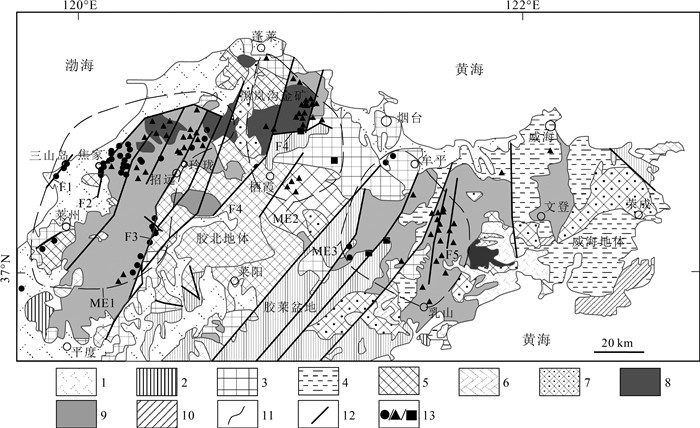
 下载:
下载:
